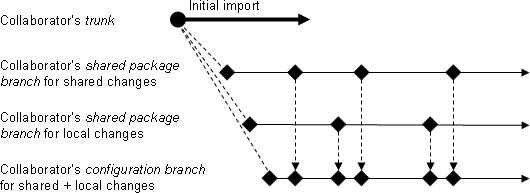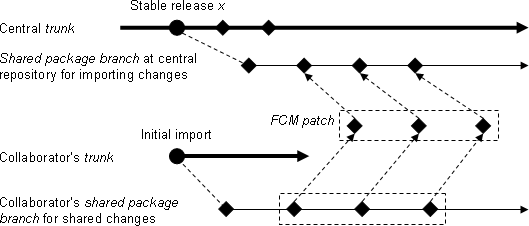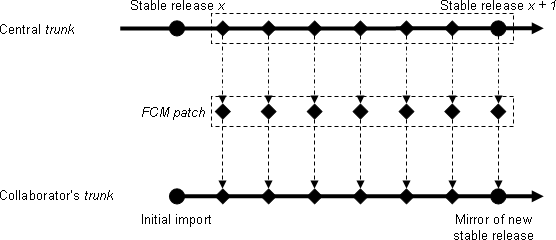

Last updated: 28 November 2006
Met Office
FitzRoy Road, Exeter
Devon, EX1 3PB
United Kingdom
© Crown Copyright 2006
Questions regarding this document or permissions to quote from it should be directed to the IPR Manager.
This document describes how projects configured under FCM can be distributed externally. Particular attention is given to collaborative distributions - where the external user regularly returns code for consolidation into the central repositories which hold the master copies of the code.
Note: This document assumes that the repositories are inaccessible to the external user, due to issues of security and practicality.
A system configured under FCM can be distributed by packaging a known revision (usually corresponding to a stable release) into an archive (e.g. a tarball) of directories and files. Various issues need to be considered:
Although we would encourage all collaborators to make use of the FCM system for version control, we recognise that they may already have their own preferred systems in place. There is no particular problem with this. The main requirement is that any proposed changes are provided as a modification relative to the provided distribution. The changeset could be provided in the form of a modified project tree or as a patchfile (refer to the man page for the Unix command patch for details). If the change involves any renaming or removal of files or directories then special instructions should be provided plus a script to perform the changes.
At the central repository, the changeset should be applied to a branch created from the repository revision which formed the basis of the changeset (possibly making use of the Subversion utility svn_load_dirs.pl). Note that extra care is needed with changesets provided as modified project trees if there are any files in the project which are excluded from the distribution. Once imported, the changeset should then undergo any necessary testing or review before being merged into the trunk.
There are a number of advantages if the FCM system is used for version control by the collaborator. In particular it means that:
This section explains the recommended way of using FCM in a collaboration.
The collaborator needs to set up a repository and import each of the projects. Please see the section Creating a repository in the FCM user guide for advice. Collaborators may wish to use separate repositories and Trac systems for each project or they may prefer to use a single repository for all projects and use a single Trac system. Either option should be fine so long as the same set of projects is retained.
After completing the initial import, the collaborator should have the required set of projects available in Subversion where the initial version of the trunk of each project corresponds with the initial stable release provided in the distribution.
The recommended way of preparing changes is illustrated in Figure 1a:

Figure 1a: working at the collaborator's site
The collaborator will create a shared package branch from the latest stable release on the trunk. This branch will contain all the changes that will eventually be fed back to the central repository. Developers will also create their own development branches. These may be branched from the latest stable release on the trunk. Alternatively, if the change needs to build on other changes then a branch can be created from the shared package branch. When the changes are ready (i.e. tested, documented, reviewed, etc) then they are merged into the shared package branch. The trunk is not used for the shared changes as it is reserved for changes received from the central repository.
Should it be required, a second shared package branch can be created from the same point to contain any local modifications that will not be fed back to the central repository. A configuration branch can then be used to combine the local changes with those destined to be fed back. This is illustrated in Figure 1b:

Figure 1b: managing local changes
Eventually, a series of changesets will exist on the first package branch. These changes will be fed back to the central repository via an "FCM patch". This contains a series of differences associated with changesets in a given branch of development, created by the fcm mkpatch command. For further information about the command, please refer to its command reference in the FCM user guide.
At the central repository, the changeset will be applied to a branch created from the repository revision which formed the basis of the changeset. This is illustrated in Figure 2:

Figure 2: feeding back changes
Patches will usually be exchanged in the form of a tarball. To apply the patch it must first be extracted to a directory. In this directory there should be a shell script called fcm-import-patch. A TARGET needs to be specified when invoking the script. The TARGET must either be a URL or a working copy of a valid project tree that can accept the import of the patches. It is essential that this target matches the version of the project from which the patch was created (usually this means a particular stable release). The script contains a series of cp and svn commands to import the changesets one by one. Note that the changesets are committed automatically with no user interaction. It is worth ensuring that an up to date backup of the repository is available in case of problems.
Once the changes have undergone any necessary testing or review they can be merged into the trunk. There are three ways of approaching this:

Figure 3a: merging a patch in a single changeset

Figure 3b: merging a patch in multiple changesets
Once a new stable release is available it will be supplied in the form of a distribution tarball as described earlier. However, collaborators will also be supplied with an "FCM patch" (as described earlier) for each project containing all the changes made since the previous stable release. Note that this assumes that stable releases are prepared on the trunk and not in branches.
Each patch should be applied to the trunk of the collaborator's repository. This means that the collaborator's trunk will always be mirroring that of the central repository. This is illustrated in Figure 4:

Figure 4: mirroring the trunk at the collaborator's site
In order to be certain that the patch has worked correctly, we recommend that a check is performed to ensure that the new stable release on the trunk matches the files provided in the distribution.
Old branches that are still active at the collaborators site should be updated to the latest stable release when it becomes available. Developers should create a new branch from the latest stable release and then merge the changes from the old branch to the new branch. The old branch should be deleted once it is no longer required. This is illustrated in Figure 5a:

Figure 5a: updating a branch to the latest stable release
Note that the merge will be easiest if the old branch was created from the previous stable release. If it was created from the shared package branch then a custom merge will be required to achieve the desired result. This is illustrated in Figure 5b:

Figure 5b: updating a branch of the shared package branch
The previous sections have only considered how developments on the trunk of a central repository can be shared with a single collaborator. However, the same techniques can be applied to more complex situations.
The previous sections have only considered the version control aspects of a collaboration. This section lists some other aspects of the collaboration which will need to be considered.